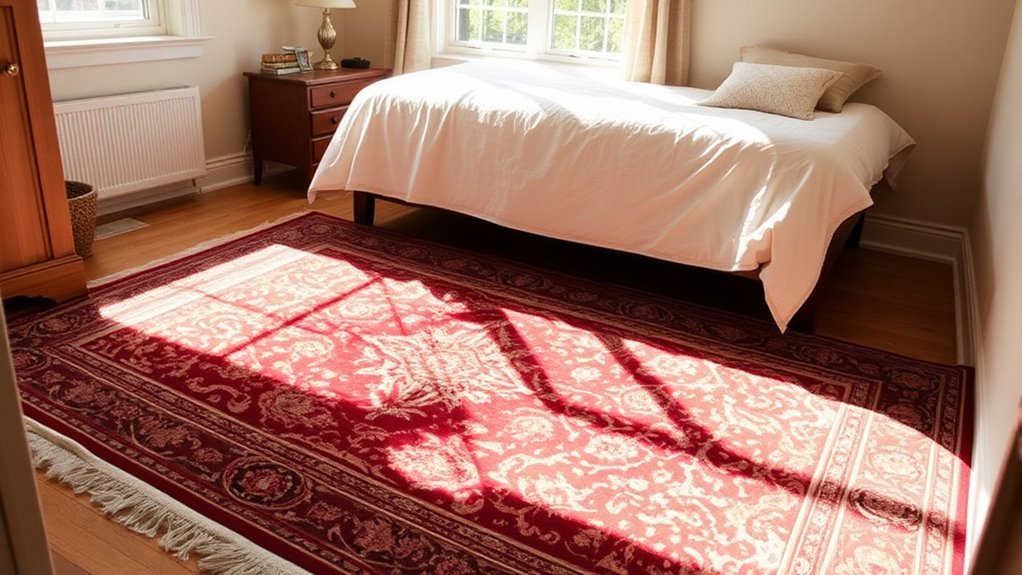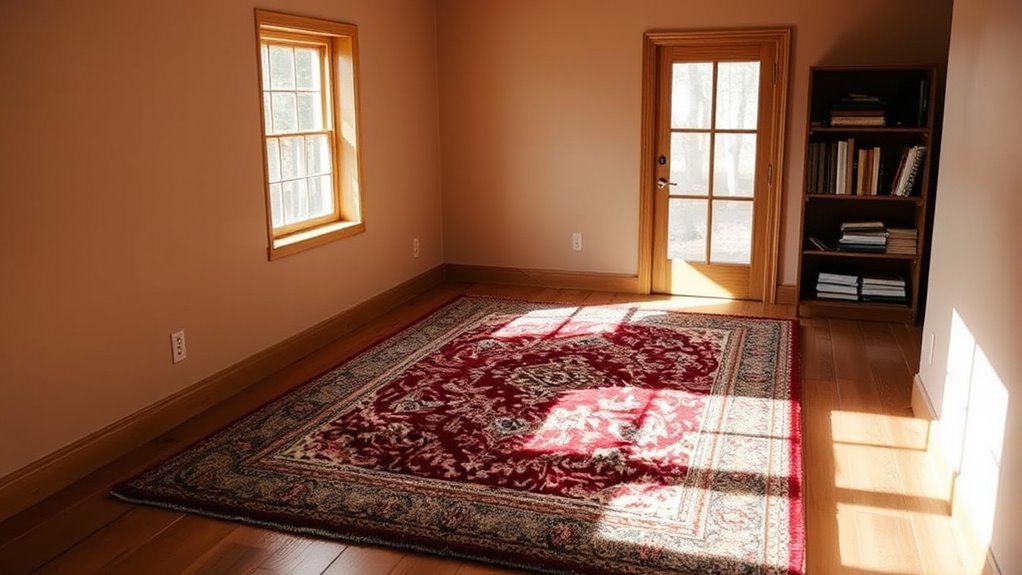To make a small room feel balanced, choose a rug that complements the space without overwhelming it. Measure your area carefully, aiming for a rug large enough to anchor furniture but leaving some floor visible around the edges for a sense of openness. Stick to rules like placing rugs under furniture legs or defining zones, and consider size guidelines from trusted sources. Keep these tips in mind, and you’ll find the perfect fit—more details await as you explore further.
Key Takeaways
- Measure room dimensions carefully to select a rug that complements the space without overwhelming it.
- Choose rugs that extend beyond furniture legs for a balanced and cohesive look.
- Leave visible floor around the edges to create a sense of openness and prevent cluttered appearance.
- Use established sizing guidelines, such as those from trusted sources like rug sizing rules, for optimal fit.
- Select appropriately sized rugs to define zones and enhance visual harmony without overcrowding the room.

Adding a rug to a small room can instantly make the space feel cozier and more inviting. When choosing rugs in small rooms, size optimization becomes essential to prevent the space from feeling cluttered or overwhelmed. The goal is to find a rug that complements the room’s dimensions without dominating it, making the area look balanced and well-proportioned. You want to avoid rugs that are either too tiny, which can look out of place, or too large, which can make the room feel cramped.
Rug placement plays a vital role in achieving this balance. In small rooms, the right placement can anchor the furniture and define different zones, such as a seating area or a sleeping nook. For example, in a compact living room, you might choose a rug that extends just beyond the front legs of your sofa and chairs. This approach creates a sense of unity without overpowering the space. If you’re working with a small bedroom, consider placing a rug under the bed, allowing it to peek out on all sides or just at the foot of the bed for a subtle touch. Proper rug placement helps in visually enlarging the space and guiding the eye across the room.
Size optimization is all about choosing a rug that fits the scale of your small room. Measure your space carefully before buying. If your room is narrow, a long, narrow runner can work well along a hallway or beside a bed. In a tiny living area, a modest rug that anchors the seating without covering the entire floor might be best. Remember, leaving some floor visible around the edges can create a sense of openness. Conversely, if your small room is more open-plan, a larger rug that defines the zone can add warmth and structure without crowding the space. The key is to pick a size that enhances the room’s proportions and allows for comfortable movement. Additionally, understanding rug sizing rules can help you make the best choice for your small space.
Frequently Asked Questions
How Do I Choose a Rug Color for Small Rooms?
To choose a rug color for your small room, focus on color coordination that complements your walls and furniture. Light, neutral hues help make the space feel larger, while bold colors can add personality. Consider pattern selection carefully; subtle patterns create visual interest without overwhelming. You want the rug to enhance the room’s overall vibe, so pick a color and pattern that balance and unify your decor seamlessly.
What Materials Are Best for Small Room Rugs?
You should choose rugs made from durable materials like wool, nylon, or polypropylene, as they withstand foot traffic and last longer. Consider texture options like plush for coziness or flatweave for easy cleaning and a sleek look. Durability is key in small rooms where rugs get more wear, so pick a material that balances comfort with resilience. This way, your rug stays beautiful and functional over time.
Can a Rug Make a Small Room Look Larger?
A rug can create a visual illusion that makes your small room seem massive—like stepping into a whole new world! You should try rug layering and placing a larger rug underneath furniture to draw the eye outward. These techniques enhance the sense of space and depth, tricking your mind into perceiving a larger room. With the right approach, your cozy space will feel surprisingly expansive and inviting.
How Often Should I Clean My Small Room Rug?
You should vacuum your small room rug at least once a week to keep it clean and free of dust. Regular vacuum maintenance prevents dirt buildup that can wear down fibers. If you notice stains, treat them promptly with stain removal techniques to keep your rug looking fresh. For deeper cleaning, consider professional cleaning every 6-12 months. This routine helps maintain your rug’s appearance and longevity in your small space.
Are There Specific Patterns That Suit Small Spaces?
Think of pattern selection as choosing a soundtrack for your space—subtle tunes can transform the mood. For small rooms, opt for simple, subtle patterns like geometric or light floral designs that create visual harmony without overwhelming. Avoid large, busy patterns that can clutter the space or make it feel cramped. Instead, select patterns that complement your decor, enhancing the room’s charm while maintaining a balanced, open feel.
Conclusion
When choosing a rug for a small room, remember that a slightly larger size can make the space feel bigger and more cohesive. Studies show that rooms with appropriately sized rugs appear 25% more spacious and inviting. So, don’t be afraid to go bigger than you think—your room will look more balanced and stylish. Ultimately, the right rug size not only enhances your décor but also creates a more comfortable, welcoming environment.









